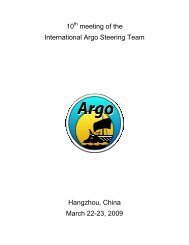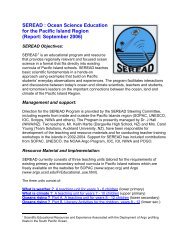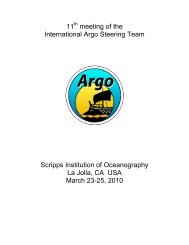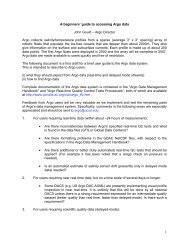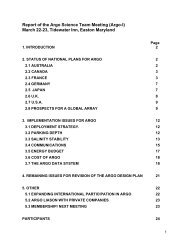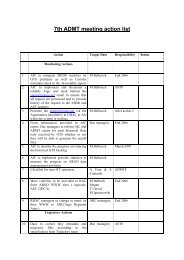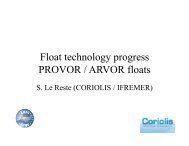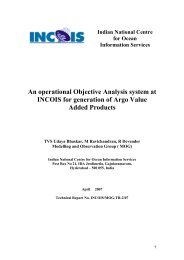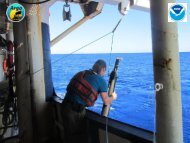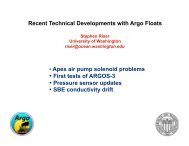AST-12 meeting report posted - Argo
AST-12 meeting report posted - Argo
AST-12 meeting report posted - Argo
Create successful ePaper yourself
Turn your PDF publications into a flip-book with our unique Google optimized e-Paper software.
The carbon-explorer float is dedicated to carbon flux studies. It emphasizes (1) sensors<br />
allowing quantification of various particle carbon pools and (2) on mission configuration (e.g.<br />
resolving the diel cycle of these variables to infer carbon fluxes).<br />
Finally, the Bio-<strong>Argo</strong> float is proposed as a rather simple float with respect to optical package<br />
[Chla fluorescence, backscattering (proxy of POC)] that could become part of the <strong>Argo</strong> array,<br />
respecting the core <strong>Argo</strong> mission rules. Optimally, these measurements should be associated<br />
to other key variables whose measurements are already implemented and operational, or<br />
nearly so, on floats (i.e. O2, NO3). The purpose of such floats is to increase the profile density<br />
of these variables that are of great biogeochemical / ecosystem relevance. Presently the Bio-<br />
<strong>Argo</strong> community is growing steadily with ~150 floats (already funded) to be deployed within the<br />
next 18 months. The community is also highly involved in the various aspects of data<br />
management and QC. Presently, a prototype of real-time QC for Chla has been developed<br />
and implemented at Coriolis. Delayed-mode QC is on the way. The community wishes to<br />
participate to the future ADMT <strong>meeting</strong>s to progressively interact and develop synergy with the<br />
<strong>Argo</strong> community at the early stage of Bio-<strong>Argo</strong> development.<br />
The submitted <strong>report</strong> to IOCCG can be obtained from Hervé Claustre. A summary of it was<br />
presented as a community white paper at the OceanObs09 conference ().<br />
Dean Roemmich welcomed the <strong>report</strong> and said that scientists within <strong>Argo</strong> would really like to<br />
embrace Bio-<strong>Argo</strong> and see that it happens, but there are a couple concerns to be addressed<br />
before that can happen. The first concern is data management and how can <strong>Argo</strong> and Bio-<br />
<strong>Argo</strong> work together to ensure that data management costs for new sensors do not eat away at<br />
<strong>Argo</strong>’s core data management costs. H. Claustre said that a person is being hired to work full<br />
time on data management with Coriolis. The second concern is EEZs and how to deal with<br />
floats equipped with bio sensors that drift into EEZs. A discussion followed with no clear<br />
outcomes, but with agreement that this issue needs to be explored more within the Bio-<strong>Argo</strong><br />
community.<br />
Action item 6: <strong>AST</strong> co-chairs to write letter to Bio<strong>Argo</strong> and IOCCG: the <strong>AST</strong> welcomed<br />
the <strong>report</strong> of the Bio<strong>Argo</strong> group, consistent with the recommended <strong>Argo</strong> enhancements from<br />
OceanObs’09, and endorses the continued development of the technology, data management<br />
and the plans in consultation with the <strong>AST</strong>. <strong>AST</strong> co-chairs.<br />
4.10 AIC and JCOMM Observing Program Support Centre<br />
M. Belbeoch, the AIC/JCOMMOPS manager, <strong>report</strong>ed on the development of the centre. The<br />
<strong>AST</strong> welcomed the new financial support from Japan (JAMSTEC) to the infrastructure. The TC<br />
recalled the centre mandate, services, and updated the <strong>AST</strong> on the staff turnover that was<br />
affecting JCOMMOPS functioning. He mentioned that his main collaborator (the<br />
DBCP/OceanSITES TC) left JCOMMOPS in August 2010 and the position should be renewed<br />
in August 2011.<br />
Nevertheless, the I.T team was strengthened by the arrival of an intern at JCOMMOPS in<br />
November (for two years). The team is now fully productive and the Google Earth application is<br />
a good example of the progress done.<br />
<strong>AST</strong> members strongly requested the TC to ensure a regular maintenance of the float database,<br />
crucial for implementation planning. The <strong>AST</strong> requested the TC make the necessary<br />
developments to finalize the “EEZ warning system” so that implementers have a minimum of<br />
15



